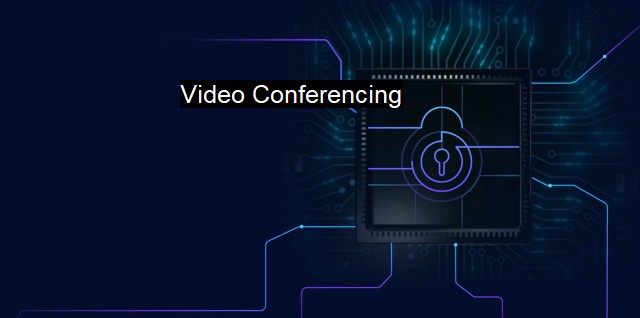What is Video Conferencing?
The Ins and Outs of Video Conferencing: Enabling Global Communication and Increasing Cybersecurity Risks
Video conferencing is a technology that allows individuals or groups to meet and interact from different locations in real-time by transmitting audio-visual data over the Internet. It is an essential tool used worldwide for various purposes, such as corporate meetings, online classes, or remote doctor appointments, making it accessible to everyone regardless of geographical location.It's important to acknowledge the various threats and vulnerabilities that surround video conferencing platforms. Growing technological advancements have unfolded a variety of security issues, that, if neglected or disregarded, may lead to grave repercussions such as confidentiality breach, network vulnerabilities, and loss of credibility.
One common attack vector against video conferencing is the interception of information sent over the network, also known as eavesdropping or snooping. Cyber-criminals might exploit flaws in the encryption protocols used by video conferencing tools to gain unauthorized access to the data being shared or transmitted, causing severe damage such as leakage of classified information, assets, and potentially leading to financial losses.
An effective deterrence method is the utilization of strong encryption mechanisms to protect data in transit. It ensures that even if the data packets get intercepted in between, the information remains inaccessible to intruders. Video conferencing platforms must, by design, use end-to-end encryption – a process in which data is converted into a code and channeled through the network where only the sender and the receiver who possesses the decryption key can decipher the message.
Phishing attacks are another common cybersecurity threat in the realm of video conferfencing. In these instances, hackers mimic official video conferencing emails or notifications in order to trick users into revealing sensitive information, such as passwords or credit card numbers. Users must be educated about these tactics and instructed not to click on any mysterious links or provide personal information unless they are sure of the source.
Unencrypted file transfers carry inherent risks during video conferences. Just like data transmitting over the network can be intercepted, files that are not correctly encrypted can become vulnerable to malicious activities. Therefore, whenever files are shared using video conferencing tools, always ensure these files are first encrypted and then transmitted.
Malicious software or malware, often injected through phishing emails or suspicious downloads, can take control of webcams and microphones, enabling cyber-criminals to snoop in on discussions. Well-equipped antivirus software programs are instrumental in mitigating the threat by identifying and blocking such threats before they manifest into disruptions.
On the other hand, DDOS or Distributed Denial of Service is a type of cyber-attack where the desired video conferencing communication network is overwhelmed with traffic, rendering it unavailable. Implementing robust intrusion prevention systems can help differentiate between legitimate and malicious traffic influx and prevent such attacks.
Unattended software updates can also make video conferencing susceptible to cyber threats. Failing to regularly implement updates leaves the platform's security features compromised. Simply put, keeping video conference tools up-to-date is a basic step to ensure the most potent protection against security threats.
Proper authentication protocols are also key to preventing unauthorized persons from thriving on video conferencing platforms. By implementing techniques such as two-factor or multi-factor authentication, only credible individuals would have access to private digital spaces.
To cap it off, security in the context of video conferencing- a seemingly simple act of communication, requires a web of intricate measures and responsibilities from both ends. From robust software features to responsible usage methods, an effective combination of these protocols can maintain the integrity and confidentiality of this technologically marvelled space, fostering its growth in the process.

Video Conferencing FAQs
What security measures should be taken during a video conference?
Some important security measures during a video conference are: checking the software's security settings, using strong passwords, using a virtual background to avoid sharing sensitive information, ensuring only authorized participants attend the meeting, and encrypting the communication.How does antivirus software help in video conferencing security?
Antivirus software helps in video conferencing security by identifying and preventing malware, viruses, and other cyber threats from infiltrating the system. It also scans the files and emails shared during the video conference, making sure they are free from any malicious software that might compromise the participants' devices.Can video conferencing software be hacked?
Yes, video conferencing software can be hacked if not secured properly. Hackers can gain access to the system through weak passwords, unsecured Wi-Fi networks, or unencrypted communication. They can also exploit vulnerabilities in the software to carry out their attacks.What should be done if there is a security breach during a video conference?
If there is a security breach during a video conference, the first step is to terminate the meeting. Then, the IT team should investigate the incident to identify the cause and extent of the breach. The affected devices should be scanned for malware, and any compromised data should be reported to the relevant authorities. Finally, security protocols should be reviewed and updated to prevent similar incidents from happening in the future.| | A | | | B | | | C | | | D | | | E | | | F | | | G | | | H | | | I | | | J | | | K | | | L | | | M | |
| | N | | | O | | | P | | | Q | | | R | | | S | | | T | | | U | | | V | | | W | | | X | | | Y | | | Z | |
| | 1 | | | 2 | | | 3 | | | 4 | | | 7 | | | 8 | | |||||||